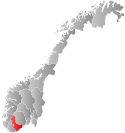|
Eide, Aust-Agder
Eide is a former municipality in the old Aust-Agder county in Norway. It is currently located within the municipality of Grimstad in Agder county. The municipality of Eide existed from 1838 until 1962. The 32.4-square-kilometre (12.5 sq mi) municipality included 29.2 square kilometres (11.3 sq mi) of land on the mainland and the rest being nearly 70 small islands off the Skaggerak coast. The larger islands include Auseøya, Homborøya, and Ålesøya.[1] The administrative centre was the village of Eide where the Eide Church is located. Other villages in Eide included Jortveit and Homborsund. History The municipality of Eide was created on 1 January 1838 (see formannskapsdistrikt law). During the 1960s, there were many municipal mergers across Norway due to the work of the Schei Committee. On 1 January 1962, the area of Gitmarkgårdene, with 22 inhabitants, was incorporated into the neighboring municipality of Lillesand. The rest of the municipality of Eide, with 504 inhabitants, was merged into the neighboring municipality of Landvik. Later, in 1971, Landvik was incorporated into the municipality of Grimstad.[4] NameThe municipality (originally the parish) is named after the old Eide farm (Old Norse: Eiði) since the first Eide Church was built there. The name is the dative case of the word eið which means "isthmus". Tis is because the farm (and church) is located between two bodies of water: the Fosdalskilen and Engekilen.[1][5] GovernmentWhile it existed, this municipality was responsible for primary education (through 10th grade), outpatient health services, senior citizen services, unemployment, social services, zoning, economic development, and municipal roads. During its existence, this municipality was governed by a municipal council of directly elected representatives. The mayor was indirectly elected by a vote of the municipal council.[6] Municipal councilThe municipal council (Herredsstyre) of Eide was made up of 13 representatives that were elected to four year terms. The tables below show the historical composition of the council by political party.
Notable people
See alsoReferences
External links
|
||||||||||||||||||||||||||||||||||||||||||||||||||||||||||||||||||||||||||||||||||||||||||||||||||||||||||||||||||||||||||||||||||||
Portal di Ensiklopedia Dunia



